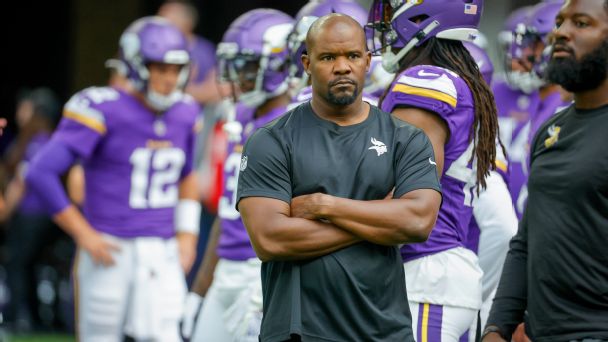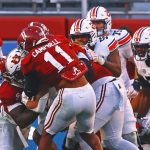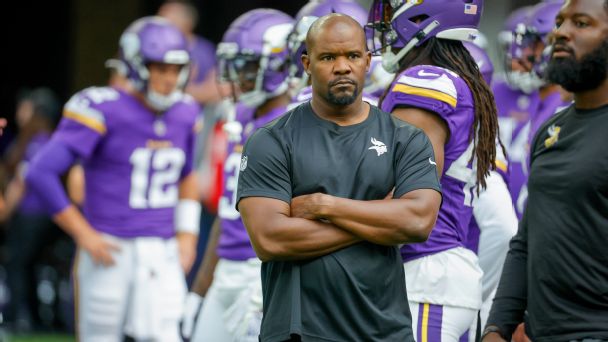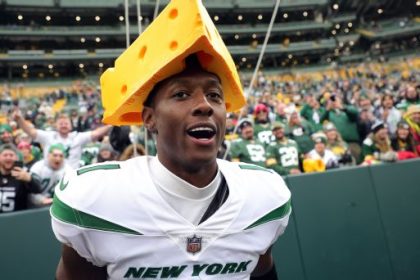
EAGAN, Minn. — A ball tips off a Minnesota Vikings cornerback’s hands and into those of an opposing receiver for a touchdown. A few minutes later, the reverse happens: The Vikings’ final pass is intercepted in the end zone after it tipped off their tight end’s hands.
A ball slides over the pylon for a touchback, rather than to the side of it for a harmless fumble out of bounds. The quarterback can’t hear a crucial playcall over the din of the home crowd, leading to 23 lost seconds in an endgame scramble.
NFL plays can be scuttled by seconds and inches, and games lost by a handful of those plays. All of them have seemingly gone against the Vikings in 2023, leading to ill-timed turnovers, cascading mistakes and an 0-3 start to the season.
It’s tempting to assume the team could steady itself by reducing those errors and resurrecting the situational mastery that powered their 13-4 season in 2022. They are, after all, the unluckiest team in the league based on a win probability metric maintained by the NFL’s analytics department.
The reality, however, seems much broader. The Vikings’ past two opponents have romped to historic days against their defense — giving up 259 rushing yards to the Philadelphia Eagles and 445 passing yards to the Los Angeles Chargers — revealing a personnel chasm that their newly aggressive defensive scheme has been unable to cover for.
An optimist would say the Vikings are losing close games — their three defeats have been by a total of 13 points — despite the performance of their defense. But during a glum news conference Monday, coach Kevin O’Connell seemed to acknowledge the deeper roots of their disappointing start.
“What we’ve got to do,” O’Connell said, “is find ways to continue evolving and changing our process to prepare to find the advantages we can to be at our best for these games.”
O’Connell has added a new level of accountability for those mistakes, threatening to bench players who don’t demonstrate ball security moving forward. The Vikings have an NFL-high nine giveaways. But the Vikings can take some solace in the fact that many of their mistakes have come from players who don’t normally make them.
Running back Alexander Mattison, who lost a fumble in Week 2 against the Eagles and has had three other fumbles overturned by officials, entered the season with two fumbles in 474 career touches. Tight end T.J. Hockenson, whose fumble in Week 3 against the Chargers ended the Vikings’ first possession, previously had two fumbles in 247 career touches. And punt returner Brandon Powell, who lost the ball after a 20-yard return in Week 2, told O’Connell he had never fumbled at any level of his football career before that moment.
The timing of those errors has made them more damaging. They’ve committed three turnovers on their opponents’ goal line, one in each of their games, and a total of seven have come inside their opponents’ territory. Simple math suggests that a touchdown on each of those goal-line turnovers alone would have overcome their margins of defeat.
But close observers of the Vikings would have good reason to question such microanalysis. At the moment, at least, their longer-term outlook is clouded by a defense that has been frighteningly vulnerable to opponents’ strengths.
As mentioned earlier, the Eagles rushed for 259 yards, including 195 before first contact. A week later, the Chargers passed for 445 yards in their 28-24 victory, completing 41 of their 48 attempts. According to the Elias Sports Bureau, there had been only four previous occasions since the 1970 AFL-NFL merger when a team allowed so many rushing and passing yards in consecutive games of a regular season.
New defensive coordinator Brian Flores has utilized a supercharged version of the scheme he implemented with great success earlier in his career as a defensive playcaller with the New England Patriots and the head coach of the Miami Dolphins. Always known as an aggressive blitzer, Flores has sent at least one extra pass-rusher more frequently (63% of pass plays) than any NFL team has in the first three weeks of a season since ESPN Stats & Info began tracking it in 2006. That’s more than twice the current league average of 26.7%, but it hasn’t disrupted opposing quarterbacks often enough.
The Vikings have the NFL’s sixth-lowest pressure rate (32%) when blitzing, largely because opposing quarterbacks are getting the ball out quickly and finding receivers left open by the extra rushers. They have used an average of 2.22 seconds before the throw against the Vikings’ blitz, the shortest time in the NFL this season.
Chargers quarterback Justin Herbert was especially effective with that approach, getting the ball out of his hands in an average of 2.18 seconds when the Vikings blitzed and overall completing 24 passes that traveled 5 or fewer yards in the air.
Speaking afterward, Vikings safety Harrison Smith said: “I wouldn’t say they were picking [the blitz] up. I’d say they were getting it out.”
In an effort to maximize the effectiveness of his approach, Flores has used imbalanced personnel groupings that invite questions about the makeup of the roster. Of the 10 defensive players with the highest percentage of snaps, five are defensive backs, four are linebackers and only one is a defensive lineman. Defensive end Dean Lowry and linebacker Pat Jones II are virtually tied for the 11th-highest rate of playing time.
Defensive tackle Harrison Phillips, whom the Vikings list at 307 pounds, has played 80.7% of snaps and has occasionally been the only defensive lineman on the field. Asked after the Eagles game about stopping the run with such a small lineup, Flores said: “I think in some instances you want to get bigger. You want bigger, more powerful people. But we’re always just trying to get the best 11 out there.”
The Vikings made a conscious decision to enter the season without a proven difference-maker on their defensive line after allowing Dalvin Tomlinson to sign a four-year contact with the Cleveland Browns worth up to $57 million. They responded by signing Lowry to a much smaller deal at $8.5 million over two years, and Flores’ personnel decisions imply a clear assessment of where he thinks their strengths and weakness lie. It’s also hard not to view his blitz frequency as an attempt to cover for what so far has appeared to be a lack of pass-rushers who can win one-on-one matchups.
With free agent acquisition Marcus Davenport sidelined for all but four snaps this season by an ankle injury, the Vikings have six sacks this season. Five have come from linebacker Danielle Hunter, who is also one of only two Vikings players that rank in the top 100 of ESPN’s pass rush win rate metric. Hunter ranks No. 65, with Jones at No. 98.
O’Connell wanted a more aggressive approach when he hired Flores to replace 2022 coordinator Ed Donatell, but through three weeks the Vikings rank No. 26 in scoring (27.3 points per game), yards (382.3) and expected points added (-5.77). It’s fair to assume that some schematic adjustments are likely in the coming weeks and potentially Sunday at the Carolina Panthers.
“As we put more on tape,” O’Connell said, “we’ve got to be ready to adjust and be ready for the counterpunches people are seeing based upon how we’re building defensive plans early on in the season. … It’s always going to come down, defensively, to those one or two or three plays that could really get you off the field and change the whole landscape of the game. I’ve got confidence in our guys to make those plays and [Flores] to get us in the right call. That’s something we’ll continue to work towards.”











